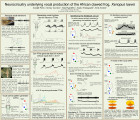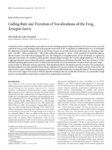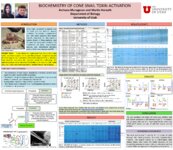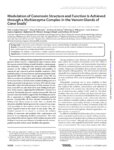|
|
Creator | Title | Description | Subject | Date |
| 1 |
 |
Yamaguchi, Ayako | Neurocircuitry underlying vocal production of the African clawed frog, Xenopus laevis | This poster describes how motor and premotor neurons are interconnected to each other using electrophysiological and pharmacological techniques. | Vocalizations; Central pattern generator; Motor programs; Premotor neurons; Whole-cell patch-clamp recordings | 2014 |
| 2 |
 |
Goller, Franz | Superfast vocal muscles control song production in songbirds | Birdsong is a widely used model for vocal learning and human speech, which exhibits high temporal and acoustic diversity. Rapid acoustic modulations are thought to arise from the vocal organ, the syrinx, by passive interactions between the two independent sound generators or intrinsic nonlinear dyna... | Vocal muscles; Syringeal muscles; Sturnus vulgaris | 2008 |
| 3 |
 |
Yamaguchi, Ayako | Distinct neural control of vocal phases in frog calls | This poster describes how the connections within the central vocal pathways of African clawed frogs are responsible for coordinating distinct part of their calls. | Vocalizations; Central pattern generators, Motor programs | 2013 |
| 4 |
 |
Goller, Franz | Motor control of crystallized song is modified by sensory feedback | Song production requires precisely coordinated activity in the respiratory and syringcal (vocal organ) muscles. Crystallized adult song is characterized by acoustic and motor stereotypy which does not require auditory feedback, suggesting it is represented by fixed central motor programs. To determ... | Air injection; Auditory feedback; Pressure | 1997 |
| 5 |
 |
Lawton, Kristy J. | Motor neurons tune premotor activity in a vertebrate central pattern generator | Central patterns generators (CPGs) are neural circuits that drive rhythmic motor output without sensory feedback. Vertebrate CPGs are generally believed to operate in a top-down manner in which premotor interneurons activate motor neurons that in turn drive muscles. In contrast, the frog (Xenopus la... | CPG; feed back; synchrony; vocal; vocalization; Xenopus | 2017 |
| 6 |
 |
Olivera, Baldomero M. | Block of Shaker K+ channels by ĸ-conotoxin PVIIA is state dependent | ĸ-conotoxin PVIIA is the first conotoxin known to interact with voltage-gated potassium channels by inhibiting Shaker-mediated currents. We studied the mechanism of inhibition and concluded that PVIIA blocks the ion pore with a 1:1 stoichiometry and that binding to open or closed channels is very d... | Conotoxins; k-conotoxin PVIIA; Potassium channel blockers; Shaker K+ channels | 1999 |
| 7 |
 |
Olivera, Baldomero M. | ?O-Conotoxins inhibit NaV channels by interfering with their voltage sensors in domain-2 | The ?O-conotoxins MrVIA and MrVIB are 31-residue peptides from Conus marmoreus, belonging to the O-superfamily of conotoxins with three disulfide bridges. They have attracted attention because they are inhibitors of tetrodotoxin-insensitive voltage-gated sodium channels (NaV1.8) and could therefore ... | | 2007 |
| 8 |
 |
Yamaguchi, Ayako | Coding rate and duration of vocalizations of the frog , Xenopus laevis | Vocalizations involve complex rhythmic motor patterns, but the underlying temporal coding mechanisms in the nervous system are poorly understood. Using a recently developed whole-brain preparation from which "fictive" vocalizations are readily elicited in vitro, we investigated the cellular basis of... | | 2012-08-29 |
| 9 |
 |
Olivera, Baldomero M. | Combined proteomic and transcriptomic interrogation of the venom gland of conus geographus uncovers novel components and functional compartmentalization | Cone snails are highly successful marine predators that use complex venoms to capture prey. At any given time, hundreds of toxins (conotoxins) are synthesized in the secretory epithelial cells of the venom gland, a long and convoluted organ that can measure 4 times the length of the snail's body. In... | | 2014-01-01 |
| 10 |
 |
Horvath, Martin P. | Biochemistry of Cone Snail toxin activation | Cone snails use venom to capture prey for food and for defense against predators. The venom is composed of over 100 active peptides that target specific receptors in the nervous system. Several of these peptides have the potential to become medicine for treatment of pain, depression, seizures, and n... | biochemistry; horvath; olivera; cone snail; toxin; nmda; elution; buffers; sparse matrix test; protease; protein; purification; neurotoxin; conotoxin | 2013 |
| 11 |
 |
Olivera, Baldomero M.; McIntosh, J. Michael | Novel post-translational modification involving bromination of tryptophan: identification of the residue, L-6-bromotryptophan, in peptides from Conus imperialis and Conus radiatus venom | We report a novel post-translational modification involving halogenation of tryptophan in peptides recovered from the venom of carnivorous marine cone snails (Conus). The residue, L-6-bromotryptophan, was identified in the sequence of a heptapeptide, isolated from Conus imperialis, a worm-hunting... | Conotoxins; Conus imperialis; Conus radiatus; L-6-bromotryptophan | 1997 |
| 12 |
 |
Gesteland, Raymond F. | Translation of Rl7 RNA fragments | Examination of the events during infection of cells by RNA phages reveals phemonomena that are surprisingly complex for a virus that has only enough information to code for three to four proteins. The coat protein is synthesized at a rapid rate through most of the infectious cycle making it the pre... | Electrophoresis; RNA, Messenger; Peptide Biosynthesis; Kinetics | 1969 |
| 13 |
 |
Capecchi, Mario R. | Sepp1UF forms are N-terminal selenoprotein P truncations that have peroxidase activity when coupled with thioredoxin reductase-1 | Mouse selenoprotein P (Sepp1) consists of an N-terminal domain (residues 1-239) that contains 1 selenocysteine (U) as residue 40 in a proposed redox-active motif (-UYLC-) and a Cterminal domain (residues 240-361) that contains 9 selenocysteines. Sepp1 transports selenium from the liver to other tiss... | | 2014-01-01 |
| 14 |
 |
Olivera, Baldomero M. | Modulation of conotoxin structure and function is achieved through a multienzyme complex in the venom glands of cone snails | Background: Conotoxins can be utilized to investigate enzyme-assisted folding of disulfide-rich peptides. Results: Various ER-resident cone snail enzymes act in concert to accelerate the oxidative folding of conotoxins and modulate their conformation by reconfiguring disulfide connectivities. Conclu... | | 2012-01-01 |
| 15 |
 |
Olivera, Baldomero M.; Yoshikami, Doju; Bulaj, Grzegorz | Structural basis for tetrodotoxin-resistant sodium channel binding by μ-conotoxin SmIIIA | SmIIIA is a new μ-conotoxin isolated recently from Conus stercusmuscarum. Although it shares several biochemical characteristics with other μ-conotoxins (the arrangement of cysteine residues and a conserved arginine believed to interact with residues near the channel pore), it has several distin... | Conotoxins; Conotoxin SmIIIA; Tetrodotoxin | 2003 |
| 16 |
 |
Carrier, David R. | Human flight and exercise in microgravity | Early experimenters in human flight learned, sometimes with fatal consequences, that the human body lacks the muscular power to fly (1). Indeed, the power demands are so great that only relatively small animals (less than 12 kg) are able to fly actively due to the interplay of morphologic scaling (m... | Human flight; Microgravity | 2000 |
| 17 |
 |
Olivera, Baldomero M. | T-superfamily of conotoxins | We report the discovery and initial characterization of the T-superfamily of conotoxins. Eight different T-superfamily peptides from five Conus species were identified; they share a consensus signal sequence, and a conserved arrangement of cysteine residues (- -CC- -CC-). T-superfamily peptides... | Conotoxins; T-superfamily | 1999 |
| 18 |
 |
Goller, Franz | Bilateral syringeal contributions to song in the zebra finch | Although central control of song production has been investigated extensively in the zebra finch (Taeniopygia guttata), much less is known about peripheral vocal motor dynamics during song. | Electromyographic activity; Sound souces; Unilateral | 2004 |
| 19 |
 |
Bowling, David R. | Interannual variation in seasonal drivers of soil respiration in a semi-arid Rocky Mountain meadow | Semi-arid ecosystems with annual moisture inputs dominated by snowmelt cover much of the western United States, and a better understanding of their seasonal drivers of soil respiration is needed to predict consequences of climatic change on soil CO2 efflux. We assessed the relative importance of tem... | | 2012-01-01 |
| 20 |
 |
Olivera, Baldomero M. | Identification of Conus peptidylprolyl cis-trans isomerases (PPIases) and assessment of their role in the oxidative folding of conotoxins | Peptidylprolyl cis-trans isomerases (PPIases) are ubiquitous proteins that catalyze the cis-trans isomerization of prolines. A number of proteins, such as Drosophila rhodopsin and the human immunodeficiency viral protein HIV-1 Gag, have been identified as endogenous substrates for PPIases. However, ... | | 2010 |
| 21 |
 |
Goller, Franz | Dynamical origin of spectrally rich vocalizations in birdsong | Birdsong is a model system for learned vocal behavior with remarkable parallels to human vocal development and sound production mechanisms. Upper vocal tract filtering plays an important role in human speech, and its importance has recently also been recognized in birdsong. However, the mechanisms... | Taeniopygia guttata; Labial oscillations; SNILC bifurcation | 2008-07 |
| 22 |
 |
Yamaguchi, Ayako | Rhythm generation, coordination, and initiation in the vocal pathways of male African clawed frogs | | central pattern generator; vocalization; parabrachial area; hindbrain; bilateral coordination; motor programs | 2016 |
| 23 |
 |
Beckerle, Mary C.; Hoffman, Laura M.; Yoshigi, Masaaki | Genetic ablation of zyxin causes Mena/VASP mislocalization, increased motility, and deficits in actin remodeling | Focal adhesions are specialized regions of the cell surface where integrin receptors and associated proteins link the extracellular matrix to the actin cytoskeleton. To define the cellular role of the focal adhesion protein zyxin, we characterized the phenotype of fibroblasts in which the zyxin gene... | Zyxin; Actin; Mena/VASP | 2006 |
| 24 |
 |
Coley, Phyllis D. | Benefits and costs of defense in a neotropical shrub | Benefits and costs are central to optimality theories of plant defense. Benefit is the gain in fitness to reducing herbivory and cost is the loss in fitness to committing resources to defense. We evaluate the benefits and costs of defense in a neotropical shrub, Psychotria horizontalis. Plants were ... | Cost of defense; Growth-defense trade-off; Exclosures; Field experiment; Herbivory; Panama; Psychotria horizontalis; Rubiaceae; Tannins; Toughness; Tropics | 1995 |
| 25 |
 |
Olivera, Baldomero M. | Subfamily Turrinae in the Philippines: the genus Turris (Roding, 1798) | Marine gastropods of the family Turridae, commonly known as turrids, comprise the largest living group of venomous snails. The taxonomy of this group, however, has been generally neglected. In this work, the genus Tunis (Roding 1798) is discussed. Out of more than 200 different turrid genera, this g... | | 1999-01-01 |

























